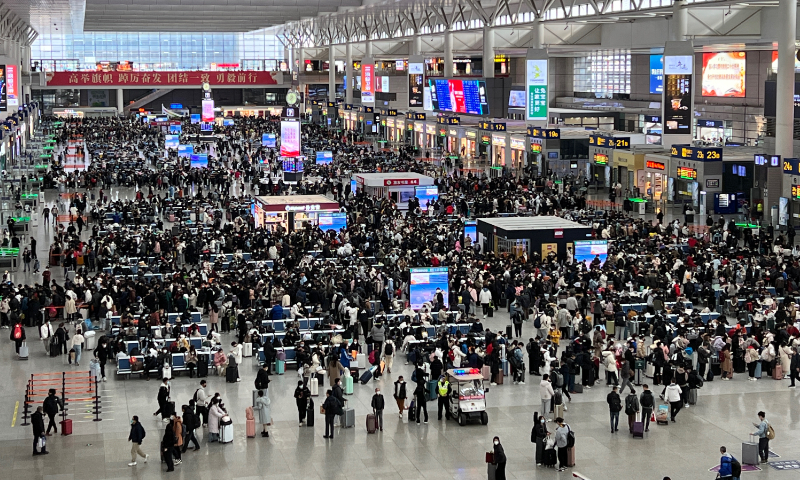Provinces roll up sleeves to reinvigorate economy
Optimized epidemic response being widely implemented across China

Passengers wait at the waiting room of Shanghai Hongqiao Railway Station in Shanghai, on December 11, 2022.
As China ramps up implementation of an optimized approach to deal with the coronavirus, local governments are moving resolutely to reinvigorate economic activities with the facilitation of flows of people and goods, among wide-ranging announcements that intend to put the world's second-largest economy back on track.
The economy is expected to gradually pick up steam in the wake of the new COVID response measures, experts said, noting that the recovery would put the economy in a better position to fend off a range of uncertainties in the coming months.
On Friday and Saturday, Sanya in South China's Hainan Province joined a provincial government-organized delegation to carry out investment promotion activities in Hong Kong, the provincial government said on Sunday.
The latest effort has seen the beach resort city team up with PricewaterhouseCoopers and other businesses to jointly explore opportunities in Hainan's free trade port, tourism and modern services. It came on the heels of an earlier Hong Kong-bound investment promotion group organized by Sanya on December 5.
In so doing, the southernmost province joins the ranks of an array of localities such as East China's Jiangsu Province and South China's Guangdong Province that have organized charter flights carrying export-oriented business executives in pursuit of opportunities in overseas markets, media reports said.
In other moves seeking to reboot the economy following a set of measures to improve COVID control and prevention, the local health commission in Shenzhen said on Sunday that travelers arriving at or departing from Shenzhen will no longer be subject to viral check and prevention measures, starting on Sunday.
In the case of Beijing, the municipal government on Tuesday unveiled measures to bail businesses out of the viral fallout. Among the new measures was the creation of a whitelist of people in key business positions who would be granted a citywide unified electronic pass to ensure their timely office attendance.
Among other examples of locally tailored support for work and production resumption was the announcement of 16 measures by the local banking and insurance bureau in Southwest China's Chongqing Municipality on Tuesday that encourage more lending by local banks to meet funding needs for the economic rebooting.
The local pro-growth moves, albeit varying in details, are considered to take advantage of the optimization tailwind as the country aims to revive its economy.
In line with the virus' new developments, the country announced 10 measures on Wednesday aimed at containing the epidemic in a more science-based and targeted fashion.
The new measures urged officials to rectify oversimplified or one-size-fits-all approaches and excessive policy steps, among admonitions intending to maximize the protection of people's lives and health, and minimize the epidemic's impact on economic and social development.
China's economic growth will likely rise to 4.5 percent in 2023 from a yearly expansion of 3 percent in 2022, read a Deutsche Bank research report sent to the Global Times over the weekend, based on the assumption that China's COVID prevention and control measures would be phased out next year. Economic growth will rise further to 6.5 percent in 2024.
Meanwhile, the yuan is expected to strengthen to 6.8 versus the US dollar by the end of 2023, according to the report, citing Xiong Yi, chief China economist at Deutsche Bank.
The onshore and offshore yuan currently hover slightly above the 7 level against the dollar. They dropped beyond 7.3 at their year-to-date lows.
The improved virus response could also stimulate home-buying demand, Xiong wrote, citing a conspicuous easing of housing policies that will support the economic recovery.
As the country's coronavirus containment measures are expected to fade away at a quicker pace in the second half of 2023, robust rebound in the housing market is on the cards, the economist said.
The optimization-induced recovery is set to hedge the economy against the downward pressure on exports amid lackluster global growth and the fallout from a continued monetary tightening on the part of the US, Tian Yun, a Beijing-based economist, told the Global Times.
Already, there are signs of a turn for the better in economic activity, as dining-in services are restored in major cities including Beijing, Guangzhou in Guangdong, and Zhengzhou in Central China's Henan Province.
Fast delivery services and cinemas are also on track for their pre-COVID hustle and bustle.
On December 5, a Monday, many provinces across the country reported that more than 70 percent of local movie theaters were operating, Xinhua reported, citing data from box office tracker Maoyan.



